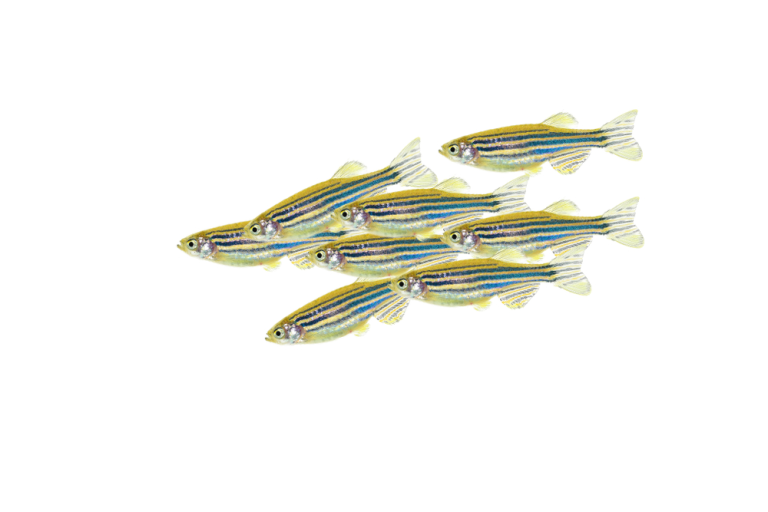Written by Dr. Marija Cvetanovic Edited by Dr. Larissa Nitschke
Elsaey and colleagues develop a new animal model of SCA1 using zebrafish. These SCA1-fish can help researchers learn more about what happens to neurons as disease progresses.
Spinocerebellar ataxia type 1 is dominantly inherited spinocerebellar ataxia caused by the lengthening of the polyglutamine repeats in the protein ataxin-1. Patients with SCA1 slowly lose their sense of balance, and can experience other symptoms like depression. Studies have shown that a key feature of SCA1 is the loss of Purkinje cells in the patient’s cerebellum.
Since the discovery of SCA1 in 1993, the use of mouse and cell models of disease have really helped researchers understand how mutant ataxin-1 affects Purkinje cells to cause SCA1 symptoms. Each model has its advantages and disadvantages. You need to consider several things when picking which model to use to study SCA1, like cost and similarity to humans.
For example, mouse models of SCA1 are useful to study pathogenesis at the molecular, cellular, tissue, and behavioral levels. But mice are costly and can take a long time to develop. It is also difficult to study the loss of Purkinje cells in live mice. On the other hand, fruit fly models are relatively cheap and grow really quickly, which allows for high-throughput studies of how different genes affect SCA1. But since fruit flies are evolutionarily distant from humans and do not have a cerebellum, they cannot be used to study Purkinje cells loss.

This is why creating a SCA1 zebrafish model is exciting. Zebrafish have very similar cerebellar anatomy and function to mammals. Also, Zebrafish larval stages are almost transparent, allowing for non-invasive imaging. Zebrafish are also much more cost-effective than mice and are easier to modify.
Previous work in Dr. Reinhard Koster’s laboratory at the Technical University in Braunschweig, Germany developed a system that allows for tunable levels of expression of different SCA mutant proteins only in Purkinje cells to model disease in zebrafish. In addition to mutant protein, Purkinje cells expressed a red protein to monitor the loss of Purkinje cells. By measuring the red signal, researchers could measure how quickly cells were lost.
The researchers in this study created SCA1-fish by expressing mutant ataxin-1 with 82 polyglutamine repeats in red Purkinje cells. Importantly, SCA1-fish showed progressive loss of Purkinje cells, just like human patients.
When healthy zebrafish are put into a new tank, after first travelling to the bottom, they like to swim up and explore the upper regions of the tank. However, while SCA1-fish were able to swim up they did not explore the upper regions indicating a decrease in this exploratory behavior. The researchers thought that this altered behavior of SCA1-fish fits well with the depression seen in patients with SCA1.
In summary, the authors developed a new model of SCA1, SCA1-fish, that can be used for non-invasive high-resolution studies of Purkinje cells loss and reduced exploratory behavior. This model opens up the door for other kinds of studies like testing the effectiveness of potential therapeutic approaches.
Key Terms
Zebrafish: A fresh water fish that is part of the minnow family. it is a useful model organism in scientific research. You can learn more about Zebrafish models in our past Research Summary about Zebrafish.
Purkinje Cells: A type of neuron in the cerebellum. They are some of the largest cells in the brain. They help regulate fine movement. Purkinje cell loss/pathology is a common feature in cerebellar ataxia.
Cerebellum: A primary area of pathology in the spinocerebellar ataxias. This brain region sits toward the back of the skull and, though small in stature, contains the majority of the nerve cells (neurons) in the central nervous system. Contains the circuits that fine-tune our movements, giving us the ability to move with precision.
Conflict of Interest Statement
The author and editor declare no conflict of interest.
Citation of Article Reviewed
Elsaey MA, Namikawa K, Köster RW. Genetic modeling of the neurodegenerative disease spinocerebellar ataxia type 1 in zebrafish. International Journal of Molecular Sciences. 2021 Jan;22(14):7351. https://www.ncbi.nlm.nih.gov/pmc/articles/PMC8306488/









